















BMW K100 |
|---|
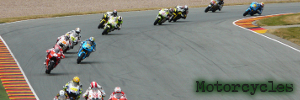
|
| Topic Navigation |
|---|
|
Wikipedia: BMW K100
Page Sections History Photographs |
History
The following section is an excerpt from Wikipedia's BMW K100 page on 4 June 2019, text available via the Creative Commons Attribution-ShareAlike 3.0 Unported License.
The BMW K100 is a family of four-cylinder 987 cc motorcycles that were manufactured by BMW from 1983 to 1992.
BMW needed to develop a clean burning four-cylinder engine quickly. While a flat-four engine would have been suited to their boxer tradition and experience, it would also give the appearance that they were copying Honda's GL1000 Gold Wing.
In 1977, Josef Fritzenwenger presented a prototype using a PSA-Renault X-Type engine from a Peugeot 104. The engine, which was installed in the 104 at a 72° angle, was laid flat in the frame with the crankshaft on the right, running parallel to the centre line of the frame. This layout, for which BMW submitted a patent application, was well suited to BMW's traditional shaft drive, needing only one 90° bevel drive to transmit power to the rear wheel. Using shaft drive with the near-vertical transverse engine preferred by the Japanese manufacturers at the time would have needed two 90° bevel drives, doubling the power lost to the inefficiency of these units. The new layout also kept the bike's centre of gravity low, which improved the bike's handling, and made space behind the front wheel available for the radiator.
Fritzwenger's concept was developed by a team led by Stefan Pachernegg based on criteria set out by R. P. Michel and K. V. Gevert. Martin Probst, who had earlier worked with the development of BMW's Formula Two engine, was responsible for engine testing and development.
As an automobile manufacturer, BMW had about twenty years of experience with liquid cooled overhead camshaft inline engines. This was carried over to the K100 engine, which used a Bosch LE-Jetronic fuel injection similar to that being introduced on their second generation 3 Series cars. Replacing the Bing carburettors traditionally used on BMW motorcycles, the fuel injection system increased power, broadened and smoothed the powerband, and reduced fuel consumption, partly by shutting off fuel under deceleration to 2000 rpm. The engine also featured a breakerless electronic ignition system.
The engine was positioned with the crankshaft on the right-hand side of the motorcycle and the cylinder head, camshafts, injectors and spark plugs on the left-hand side. This improved access to the engine over that of a conventional design, where the crankshaft would be at the bottom and the cylinder head and associated parts would be between the engine block and the upper frame.
A single-sided hollow swingarm enclosing the drive shaft provides right side drive through the gearbox and to the rear wheel. The 3-into-1 all stainless steel exhaust exits on the left hand side.
Brakes are two-piston Brembo callipers onto undrilled discs. Two different fork manufactures are used: Showa with an outer upper tube diameter of 1.612 in (40.9 mm) and Fichtel and Sachs measuring 1.627 in (41.3 mm).
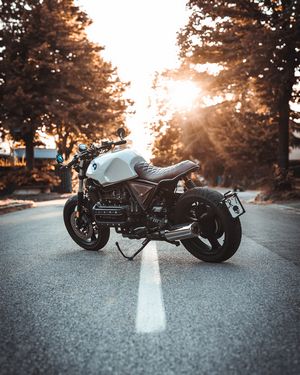 |
Photo by Fabio Spinelli
View photo of BMW K100 - 2.9MB |
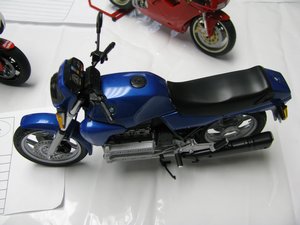 |
1:12 scale Tamiya kit & paints Box stock Photo ©2008 Bill Crittenden  2008 Summer NNL August 3, 2008 View photo of BMW K100 Tamiya Model - 2,844KB |
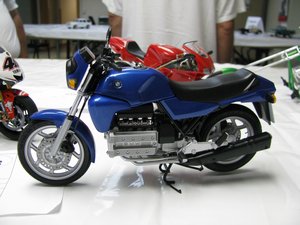 |
1:12 scale Tamiya kit & paints Box stock Photo ©2008 Bill Crittenden  2008 Summer NNL August 3, 2008 View photo of BMW K100 Tamiya Model - 3,139KB |
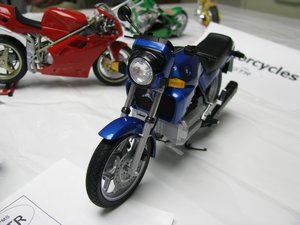 |
1:12 scale Tamiya kit & paints Box stock Photo ©2008 Bill Crittenden  2008 Summer NNL August 3, 2008 View photo of BMW K100 Tamiya Model - 2,875KB |
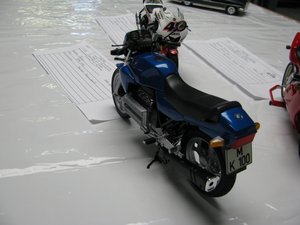 |
1:12 scale Tamiya kit & paints Box stock Photo ©2008 Bill Crittenden  2008 Summer NNL August 3, 2008 View photo of BMW K100 Tamiya Model - 2,886KB |
